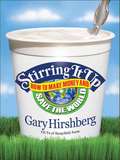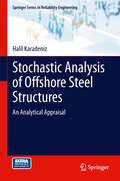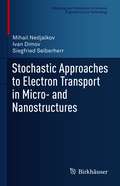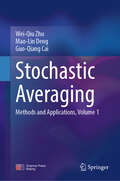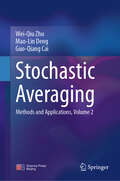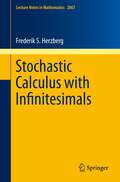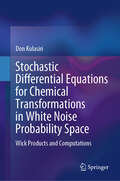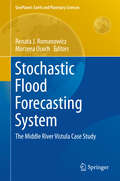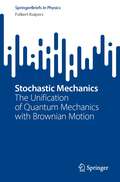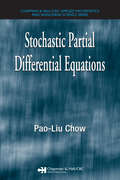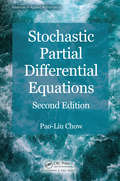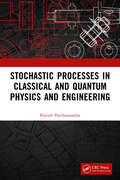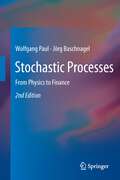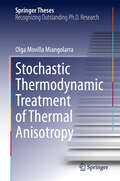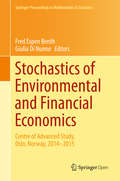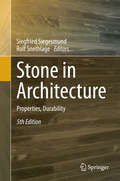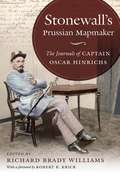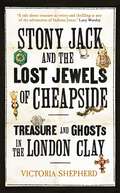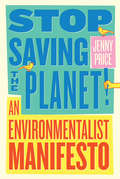- Table View
- List View
Stinking Stones and Rocks of Gold: Phosphate, Fertilizer, and Industrialization in Postbellum South Carolina (New Perspectives on the History of the S)
by Shepherd W. McKinleySouth Carolina Historical Society George C. Rogers Jr. Book Award "A solid contribution."--Journal of American History "An insightful analysis of the rise of the phosphate and fertilizer industries in the South Carolina lowcountry."--Business History Review "Places the rise of these industries in the context of the struggle for southern economic leadership in the years following the Civil War. . . . A well-written, engaging history."--Journal of Economic History "McKinley posits that the fertilizer industry emancipated former planter elites from the slave-based antebellum economy. . . . Ultimately, manufactured fertilizer contributed to fundamental changes in southern agriculture."--American Historical Review "A significant contribution to the story of industrialization in the New South."--Choice "Illustrates how South Carolina’s abundant phosphate deposits bred vibrant mining and fertilizer industries in Charleston and adjacent environs that helped reshape land, labor, and economy in the heartland of the former Confederacy."--Journal of Southern History "A finely layered and important study that fills in gaps in the industrial history of the New South and especially low-country South Carolina."--Sidney Bland, author of Preserving Charleston's Past, Shaping Its Future: The Life and Times of Susan Pringle Frost "Skillfully blurs the old, comfortable line between Old and New South economies and paints a nuanced picture of the new labor relations in the post-slavery era."--Charles Holden, author of In the Great Maelstrom In the first book ever written about the impact of phosphate mining on the South Carolina plantation economy, Shepherd McKinley explains how the convergence of the phosphate and fertilizer industries carried long-term impacts for America and the South. Fueling the rapid growth of lowcountry fertilizer companies, phosphate mining provided elite plantation owners a way to stem losses from emancipation. At the same time, mining created an autonomous alternative to sharecropping, enabling freed people to extract housing and labor concessions. Stinking Stones and Rocks of Gold develops an overarching view of what can be considered one of many key factors in the birth of southern industry. This top-down, bottom-up history (business, labor, social, and economic) analyzes an alternative path for all peoples in the post-emancipation South.
Stirring It Up: How to Make Money and Save the World
by Gary HirshbergA true force for change, Gary Hirshberg has been at the forefront of movements working for environmental and social transformation for 30 years. From his early days as an educator and activist to his current position as President and CE-Yo of Stonyfield Farm, the world's largest organic yogurt company, Hirshberg's positive outlook has inspired thousands of people to recognize their ability to make the world a better place.In Stirring It Up, Hirshberg calls on individuals to realize their power to effect change in the marketplace--"the power of one"--while proving that environmental commitment makes for a healthier planet and a healthier bottom line. Drawing from his 25 years' experience growing Stonyfield Farm from a 7-cow start-up, as well as the examples of like-minded companies, such as Newman's Own, Patagonia, Wal-Mart and Timberland, Hirshberg presents stunning evidence that business not only can save the planet, but is able to simultaneously deliver higher growth and superior profits as well.Hirshberg illustrates his points with practical information and advice, as well as engaging anecdotes from what he calls "the bad old days" of his yogurt company: how a power outage left him milking cows by hand, how a dumpster fire revealed the need for better packaging, and his camel manure taste test challenge to a local shock jock. He also describes hands-on grassroots marketing strategies--printing yogurt lids with provocative, politically charged messages, handing out thousands of free samples to subway commuters to thank them for using public transit, and devising the country's first organic vending machine--explaining how these approaches make a much more powerful impact on consumers than traditional advertising.An inspiring book for business owners and managers as well as anyone interested in saving the environment, Stirring It Up demonstrates how companies can work to save the planet, while achieving greater profits and satisfaction, and how we can all use the power of conscious consumption to encourage green corporate behavior.
Stochastic Analysis of Offshore Steel Structures
by Halil KaradenizStochastic Analysis of Offshore Steel Structures provides a clear and detailed guide to advanced analysis methods of fixed offshore steel structures using 3D beam finite elements under random wave and earthquake loadings. Advanced and up-to-date research results are coupled with modern analysis methods and essential theoretical information to consider optimal solutions to structural issues. As these methods require and use knowledge of different subject matters, a general introduction to the key areas is provided. This is followed by in-depth explanations supported by design examples, relevant calculations and supplementary material containing related computer programmers. By combining this theoretical and practical approach Stochastic Analysis of Offshore Steel Structures cover a range of key concepts in detail including: The basic principles of standard 3D beam finite elements and special connections, Wave loading - from hydrodynamics to the calculation of wave loading on structural members, Stochastic response calculations with corresponding solution algorithms including earthquakes, and Fatigue damage, reliability calculation and reliability based design optimization. The broad and detailed coverage makes this a solid reference for research oriented studies and practical sophisticated design methods. Students, researchers, insuring bodies and practical designer offices can turn to Stochastic Analysis of Offshore Steel Structures to broaden their theoretical understanding and develop their practical designs and applications of 3D finite analysis in fixed offshore steel structures.
Stochastic Approaches to Electron Transport in Micro- and Nanostructures (Modeling and Simulation in Science, Engineering and Technology)
by Ivan Dimov Siegfried Selberherr Mihail NedjalkovThe book serves as a synergistic link between the development of mathematical models and the emergence of stochastic (Monte Carlo) methods applied for the simulation of current transport in electronic devices. Regarding the models, the historical evolution path, beginning from the classical charge carrier transport models for microelectronics to current quantum-based nanoelectronics, is explicatively followed. Accordingly, the solution methods are elucidated from the early phenomenological single particle algorithms applicable for stationary homogeneous physical conditions up to the complex algorithms required for quantum transport, based on particle generation and annihilation. The book fills the gap between monographs focusing on the development of the theory and the physical aspects of models, their application, and their solution methods and monographs dealing with the purely theoretical approaches for finding stochastic solutions of Fredholm integral equations.
Stochastic Averaging: Methods and Applications, Volume 1
by Wei-Qiu Zhu Mao-Lin Deng Guo-Qiang CaiThe stochastic averaging methods are among the most effective and widely applied approximate methods for studying nonlinear stochastic dynamics. Upon an overview of global research on the subject, the book highlights a comprehensive summary of research results obtained by the group led by Professor Weiqiu Zhu at Zhejiang University in China and the group led by Professors Y. K. Lin and G. Q. Cai at Florida Atlantic University in the USA over the past three decades. The books are structured to progress logically from foundational principles to simple problems and then to increasingly complex applications. To facilitate understanding and mastery of the methods, the books offer essential preliminary knowledge and a wealth of examples. The book comprises two volumes. Volume 1 introduces the basic principles of stochastic averaging methods and their applications to single-degree-of-freedom systems under various random excitations. It also covers stochastic averaging methods for quasi-Hamiltonian systems subjected to different random excitations, including Gaussian white noise, combined Gaussian and Poisson white noises, and fractional Gaussian noise. Volume 2 explores stochastic averaging methods for quasi-integrable Hamiltonian systems under colored noise excitation, quasi-integrable Hamiltonian systems with genetic effects under Gaussian white noise and colored noise excitations, and quasi-generalized Hamiltonian systems under Gaussian white noise excitation. Additionally, it covers applications of these methods in ecosystems and some other natural science and engineering scenarios. These books serve as both introductory texts and valuable reference resources for readers in higher education and research institutions who are interested in or actively engaged in research involving nonlinear stochastic dynamics. The fields covered include mechanics, physics, chemistry, biology, ecology, astronautics and aeronautics, oceanography, civil engineering, mechanical engineering, and electrical engineering.
Stochastic Averaging: Methods and Applications, Volume 2
by Wei-Qiu Zhu Mao-Lin Deng Guo-Qiang CaiThe stochastic averaging methods are among the most effective and widely applied approximate methods for studying nonlinear stochastic dynamics. Upon an overview of global research on the subject, the book highlights a comprehensive summary of research results obtained by the group led by Professor Weiqiu Zhu at Zhejiang University in China and the group led by Professors Y. K. Lin and G. Q. Cai at Florida Atlantic University in the USA over the past three decades. The books are structured to progress logically from foundational principles to simple problems and then to increasingly complex applications. To facilitate understanding and mastery of the methods, the books offer essential preliminary knowledge and a wealth of examples. The book comprises two volumes. Volume 1 introduces the basic principles of stochastic averaging methods and their applications to single-degree-of-freedom systems under various random excitations. It also covers stochastic averaging methods for quasi-Hamiltonian systems subjected to different random excitations, including Gaussian white noise, combined Gaussian and Poisson white noises, and fractional Gaussian noise. Volume 2 explores stochastic averaging methods for quasi-integrable Hamiltonian systems under colored noise excitation, quasi-integrable Hamiltonian systems with genetic effects under Gaussian white noise and colored noise excitations, and quasi-generalized Hamiltonian systems under Gaussian white noise excitation. Additionally, it covers applications of these methods in ecosystems and some other natural science and engineering scenarios. These books serve as both introductory texts and valuable reference resources for readers in higher education and research institutions who are interested in or actively engaged in research involving nonlinear stochastic dynamics. The fields covered include mechanics, physics, chemistry, biology, ecology, astronautics and aeronautics, oceanography, civil engineering, mechanical engineering, and electrical engineering.
Stochastic Calculus and Differential Equations for Physics and Finance
by Joseph L. MccauleyStochastic calculus provides a powerful description of a specific class of stochastic processes in physics and finance. However, many econophysicists struggle to understand it. This book presents the subject simply and systematically, giving graduate students and practitioners a better understanding and enabling them to apply the methods in practice. The book develops Ito calculus and Fokker-Planck equations as parallel approaches to stochastic processes, using those methods in a unified way. The focus is on nonstationary processes, and statistical ensembles are emphasized in time series analysis. Stochastic calculus is developed using general martingales. Scaling and fat tails are presented via diffusive models. Fractional Brownian motion is thoroughly analyzed and contrasted with Ito processes. The Chapman-Kolmogorov and Fokker-Planck equations are shown in theory and by example to be more general than a Markov process. The book also presents new ideas in financial economics and a critical survey of econometrics.
Stochastic Calculus with Infinitesimals
by Frederik S. HerzbergStochastic analysis is not only a thriving area of pure mathematics with intriguing connections to partial differential equations and differential geometry. It also has numerous applications in the natural and social sciences (for instance in financial mathematics or theoretical quantum mechanics) and therefore appears in physics and economics curricula as well. However, existing approaches to stochastic analysis either presuppose various concepts from measure theory and functional analysis or lack full mathematical rigour. This short book proposes to solve the dilemma: By adopting E. Nelson's "radically elementary" theory of continuous-time stochastic processes, it is based on a demonstrably consistent use of infinitesimals and thus permits a radically simplified, yet perfectly rigorous approach to stochastic calculus and its fascinating applications, some of which (notably the Black-Scholes theory of option pricing and the Feynman path integral) are also discussed in the book.
Stochastic Differential Equations for Chemical Transformations in White Noise Probability Space: Wick Products and Computations
by Don KulasiriThis book highlights the applications of stochastic differential equations in white noise probability space to chemical reactions that occur in biology. These reactions operate in fluctuating environments and are often coupled with each other. The theory of stochastic differential equations based on white noise analysis provides a physically meaningful modelling framework. The Wick product-based calculus for stochastic variables is similar to regular calculus; therefore, there is no need for Ito calculus. Numerical examples are provided with novel ways to solve the equations. While the theory of white noise analysis is well developed by mathematicians over the past decades, applications in biophysics do not exist. This book provides a bridge between this kind of mathematics and biophysics.
Stochastic Flood Forecasting System
by Renata J. Romanowicz Marzena OsuchThis book presents the novel formulation and development of a Stochastic Flood Forecasting System, using the Middle River Vistula basin in Poland as a case study. The system has a modular structure, including models describing the rainfall-runoff and snow-melt processes for tributary catchments and the transformation of a flood wave within the reach. The sensitivity and uncertainty analysis of the elements of the study system are performed at both the calibration and verification stages. The spatial and temporal variability of catchment land use and river flow regime based on analytical studies and measurements is presented. A lumped parameter approximation to the distributed modelling of river flow is developed for the purpose of flow forecasting. Control System based emulators (Hammerstein-Wiener models) are applied to on-line data assimilation. Medium-range probabilistic weather forecasts (ECMWF) and on-line observations of temperature, precipitation and water levels are used to prolong the forecast lead time. The potential end-users will also benefit from a description of social vulnerability to natural hazards in the study area.
Stochastic Mechanics: The Unification of Quantum Mechanics with Brownian Motion (SpringerBriefs in Physics)
by Folkert KuipersStochastic mechanics is a theory that holds great promise in resolving the mathematical and interpretational issues encountered in the canonical and path integral formulations of quantum theories. It provides an equivalent formulation of quantum theories, but substantiates it with a mathematically rigorous stochastic interpretation by means of a stochastic quantization prescription.The book builds on recent developments in this theory, and shows that quantum mechanics can be unified with the theory of Brownian motion in a single mathematical framework. Moreover, it discusses the extension of the theory to curved spacetime using second order geometry, and the induced Itô deformations of the spacetime symmetries.The book is self-contained and provides an extensive review of stochastic mechanics of the single spinless particle. The book builds up the theory on a step by step basis. It starts, in chapter 2, with a review of the classical particle subjected to scalar and vector potentials. In chapter 3, the theory is extended to the study of a Brownian motion in any potential, by the introduction of a Gaussian noise. In chapter 4, the Gaussian noise is complexified. The result is a complex diffusion theory that contains both Brownian motion and quantum mechanics as a special limit. In chapters 5, the theory is extended to relativistic diffusion theories. In chapter 6, the theory is further generalized to the context of pseudo-Riemannian geometry. Finally, in chapter 7, some interpretational aspects of the stochastic theory are discussed in more detail. The appendices concisely review relevant notions from probability theory, stochastic processes, stochastic calculus, stochastic differential geometry and stochastic variational calculus.The book is aimed at graduate students and researchers in theoretical physics and applied mathematics with an interest in the foundations of quantum theory and Brownian motion. The book can be used as reference material for courses on and further research in stochastic mechanics, stochastic quantization, diffusion theories on curved spacetimes and quantum gravity.
Stochastic Numerical Methods
by Raúl Toral Pere ColetStochastic Numerical Methods introduces at Master level the numerical methods that use probability or stochastic concepts to analyze random processes. The book aims at being rather general and is addressed at students of natural sciences (Physics, Chemistry, Mathematics, Biology, etc.) and Engineering, but also social sciences (Economy, Sociology, etc.) where some of the techniques have been used recently to numerically simulate different agent-based models. Examples included in the book range from phase-transitions and critical phenomena, including details of data analysis (extraction of critical exponents, finite-size effects, etc.), to population dynamics, interfacial growth, chemical reactions, etc. Program listings are integrated in the discussion of numerical algorithms to facilitate their understanding. From the contents: Review of Probability Concepts Monte Carlo Integration Generation of Uniform and Non-uniform Random Numbers: Non-correlated Values Dynamical Methods Applications to Statistical Mechanics Introduction to Stochastic Processes Numerical Simulation of Ordinary and Partial Stochastic Differential Equations Introduction to Master Equations Numerical Simulations of Master Equations Hybrid Monte Carlo Generation of n-Dimensional Correlated Gaussian Variables Collective Algorithms for Spin Systems Histogram Extrapolation Multicanonical Simulations
Stochastic Partial Differential Equations
by Pao-Liu ChowAs a relatively new area in mathematics, stochastic partial differential equations (PDEs) are still at a tender age and have not yet received much attention in the mathematical community. Filling the void of an introductory text in the field, Stochastic Partial Differential Equations introduces PDEs to students familiar with basic probability theor
Stochastic Partial Differential Equations
by Pao-Liu ChowExplore Theory and Techniques to Solve Physical, Biological, and Financial Problems Since the first edition was published, there has been a surge of interest in stochastic partial differential equations (PDEs) driven by the Levy type of noise. Stochastic Partial Differential Equations, Second Edition incorporates these recent developments and impro
Stochastic Processes and Applications: SPAS2017, Västerås and Stockholm, Sweden, October 4-6, 2017 (Springer Proceedings in Mathematics & Statistics #271)
by Anatoliy Malyarenko Sergei Silvestrov Milica RančićThis book highlights the latest advances in stochastic processes, probability theory, mathematical statistics, engineering mathematics and algebraic structures, focusing on mathematical models, structures, concepts, problems and computational methods and algorithms important in modern technology, engineering and natural sciences applications.It comprises selected, high-quality, refereed contributions from various large research communities in modern stochastic processes, algebraic structures and their interplay and applications. The chapters cover both theory and applications, illustrated by numerous figures, schemes, algorithms, tables and research results to help readers understand the material and develop new mathematical methods, concepts and computing applications in the future. Presenting new methods and results, reviews of cutting-edge research, and open problems and directions for future research, the book serves as a source of inspiration for a broad spectrum of researchers and research students in probability theory and mathematical statistics, applied algebraic structures, applied mathematics and other areas of mathematics and applications of mathematics.The book is based on selected contributions presented at the International Conference on “Stochastic Processes and Algebraic Structures – From Theory Towards Applications” (SPAS2017) to mark Professor Dmitrii Silvestrov’s 70th birthday and his 50 years of fruitful service to mathematics, education and international cooperation, which was held at Mälardalen University in Västerås and Stockholm University, Sweden, in October 2017.
Stochastic Processes in Classical and Quantum Physics and Engineering
by Harish ParthasarathyThis book covers a wide range of problems involving the applications of stochastic processes, stochastic calculus, large deviation theory, group representation theory and quantum statistics to diverse fields in dynamical systems, electromagnetics, statistical signal processing, quantum information theory, quantum neural network theory, quantum filtering theory, quantum electrodynamics, quantum general relativity, string theory, problems in biology and classical and quantum fluid dynamics. The selection of the problems has been based on courses taught by the author to undergraduates and postgraduates in Electronics and Communications Engineering. Print edition not for sale in South Asia (India, Sri Lanka, Nepal, Bangladesh, Pakistan or Bhutan).
Stochastic Processes: From Physics to Finance
by Wolfgang Paul Jörg BaschnagelThis book introduces the theory of stochastic processes with applications taken from physics and finance. Fundamental concepts like the random walk or Brownian motion but also Levy-stable distributions are discussed. Applications are selected to show the interdisciplinary character of the concepts and methods. In the second edition of the book a discussion of extreme events ranging from their mathematical definition to their importance for financial crashes was included. The exposition of basic notions of probability theory and the Brownian motion problem as well as the relation between conservative diffusion processes and quantum mechanics is expanded. The second edition also enlarges the treatment of financial markets. Beyond a presentation of geometric Brownian motion and the Black-Scholes approach to option pricing as well as the econophysics analysis of the stylized facts of financial markets, an introduction to agent based modeling approaches is given.
Stochastic Thermodynamic Treatment of Thermal Anisotropy (Springer Theses)
by Olga Movilla MiangolarraThis thesis advances our understanding of how thermal anisotropy can be exploited to extract work through a mechanism that is quite distinct from the classical Carnot heat engine. Anisotropy, the presence of thermal or chemical gradients, is ubiquitous in the real world and powers the cascade of processes that sustain life. The thesis quantifies, for the first time, the maximum amount of power and efficiency that a suitable mechanism (a Brownian gyrator) can achieve in such conditions. An important contribution at the center of the thesis is to lay out a geometric framework that brings out the importance of an isoperimetric problem to analyze and quantify optimal operation of thermodynamic engines that harvest energy when simultaneously in contact with several heat baths. Fundamental bounds are derived via isoperimetric inequalities which capture the trade-off between work and dissipation that accrue during thermodynamic cycles. A geometric theory that allows such insights is explained first – the theory of optimal mass transport – followed by rudiments of stochastic thermodynamics that allow for quantification of work and entropy production during finite-time thermodynamic transitions. The thesis further explores entropy production due to heat flowing between heat baths of different temperature through the system dynamics, and concludes with analysis as a proof-of-concept of an autonomous engine that harvests energy from a thermal gradient to continuously produce work in a stable limit cycle operation.
Stochastics of Environmental and Financial Economics
by Fred Espen Benth Giulia Di NunnoThese Proceedings offer a selection of peer-reviewed research and survey papers by some of the foremost international researchers in the fields of finance, energy, stochastics and risk, who present their latest findings on topical problems. The papers cover the areas of stochastic modeling in energy and financial markets; risk management with environmental factors from a stochastic control perspective; and valuation and hedging of derivatives in markets dominated by renewables, all of which further develop the theory of stochastic analysis and mathematical finance. The papers were presented at the first conference on "Stochastics of Environmental and Financial Economics (SEFE)", being part of the activity in the SEFE research group of the Centre of Advanced Study (CAS) at the Academy of Sciences in Oslo, Norway during the 2014/2015 academic year.
Stolen Water
by W. Hodding CarterWhen the Comprehensive Everglades Restoration Plan went into effect during the Clinton administration, Florida's great grassy wilderness garnered a host of national attention -- and has since become a breeding ground for environmental dispute. What does it take to "save" a forest? How can it be preserved? Enter W. Hodding Carter. For an Outside magazine feature he's agreed to paddle the ninety-nine-mile waterway in Everglades National Park to examine the landscape from all angles -- physical, political, cultural, and very personal -- and get to the rock-bottom heart of the story. Stolen Water is the outgrowth of Carter's journey. Through investigative research, eyewitness accounts, and interviews with key players in the conservation controversy, Carter offers a rare portrait of a national treasure. Utterly important, and at times downright hilarious, Stolen Water is a classic American adventure tale, and an environmental parable for our time.
Stone in Architecture
by Rolf Snethlage Siegfried SiegesmundThe weathering of historical buildings and, indeed, of monuments and sculptures of natural stone is a problem that has been encountered for hundreds of years. However, a dramatic increase in deterioration in the structure of our built heritage has been observed during the past century. To understand the complex interaction that the stone in a building suffers with its near environment (the building) and the macro environment (the local climate and atmospheric conditions) requires an interdisciplinary approach and the application of many disciplines. Climate change over the next 100 years is likely to have a range of direct and indirect impacts on many natural and physical environments, including the built environment. The protection of our architectural heritage has both cultural and historical importance, as well as substantial economic and ecological value. Large sums of money are being spent world-wide on measures for the preservation of monuments and historical buildings. The past few decades has seen an unprecedented level of research activity in this area, the results of which are often difficult to access and are summarized in the new edition of STONE IN ARCHITECTURE.
Stonehenge - A New Understanding: Solving The Mysteries Of The Greatest Stone Age Monument
by Mike Parker Pearson“The most authoritative, important book on Stonehenge to date.”—Kirkus, starred review Stonehenge stands as an enduring link to our prehistoric ancestors, yet the secrets it has guarded for thousands of years have long eluded us. Until now, the millions of enthusiasts who flock to the iconic site have made do with mere speculation—about Stonehenge’s celestial significance, human sacrifice, and even aliens and druids. One would think that the numerous research expeditions at Stonehenge had left no stone unturned. Yet, before the Stonehenge Riverside Project—a hugely ambitious, seven-year dig by today’s top archaeologists—all previous digs combined had only investigated a fraction of the monument, and many records from those earlier expeditions are either inaccurate or incomplete. Stonehenge—A New Understanding rewrites the story. From 2003 to 2009, author Mike Parker Pearson led the Stonehenge Riverside Project, the most comprehensive excavation ever conducted around Stonehenge. The project unearthed a wealth of fresh evidence that had gone untouched since prehistory. Parker Pearson uses that evidence to present a paradigm-shifting theory of the true significance that Stonehenge held for its builders—and mines his field notes to give you a you-are-there view of the dirt, drama, and thrilling discoveries of this history-changing archaeological dig.
Stonewall's Prussian Mapmaker
by Robert K. Krick Richard Brady WilliamsPrussian-born cartographer Oscar Hinrichs was a key member of Stonewall Jackson's staff, collaborated on maps with Jedediah Hotchkiss, and worked alongside such prominent Confederate leaders as Joe Johnston, Richard H. Anderson, and Jubal Early. After being smuggled along the Rebel Secret Line in southern Maryland by John Surratt Sr., his wife Mary, and other Confederate sympathizers, Hinrichs saw action in key campaigns from the Shenandoah Valley and Antietam to Gettysburg, Petersburg, and Appomattox. After the Confederate surrender, Hinrichs was arrested alongside his friend Henry Kyd Douglas and imprisoned under suspicion of having played a role in the Booth conspiracy, though the charges were later dropped.Hinrichs's detailed wartime journals, published here for the first time, shed new light on mapmaking as a tool of war, illuminate Stonewall Jackson's notoriously superior strategic and tactical use of terrain, and offer unique perspectives on the lives of common soldiers, staff officers, and commanders in Lee's army. Impressively comprehensive, Hinrichs's writings constitute a valuable and revelatory primary source from the Civil War era.
Stony Jack and the Lost Jewels of Cheapside: Treasure and Ghosts in the London Clay
by Victoria ShepherdA thrilling history of mudlarkers, charlatans, experts and chancers – the underbelly of the Edwardian antiques trade. 'What a story! And how skilfully told! A tale about treasure, as twisty and thrilling as any of the adventures of Indiana Jones.' Lucy Worsley June 1912. A pair of workmen deposit a heavy ball of clay in the antiques shop of George Fabian Lawrence, or &‘Stony Jack&’ as he's better known. As Lawrence picks through the mud, a speck of gold catches his eye. A pearl earring tumbles into his hand, then another. A Burmese ruby follows; then Colombian emeralds, lapis lazuli from Afghanistan and turquoise from Iran; tankards; watches; topaz; amazonite. Stony Jack has discovered the greatest single cache of Elizabethan treasure. Diving into London&’s bustling, sometimes lawless, antiques trade at the turn of the century, Victoria Shepherd provides a compelling portrait of the city at the height of empire. A thrilling ride through Edwardian London, from the marble halls of the British Museum to the East End's maze of tenements and alleyways, Stony Jack and the Lost Jewels of Cheapside oversees the transformation of the city into a modern metropolis.
Stop Saving the Planet!: An Environmentalist Manifesto
by Jenny Price"Pithy, funny, exasperated, and informed…You cannot read a more important hundred pages than Stop Saving the Planet!" —Richard White, author of The Republic for Which It Stands We’ve been "saving the planet" for decades!…And environmental crises just get worse. All this hybrid driving and LEED building and carbon trading seems to accomplish little to nothing—and low-income communities continue to suffer the worst consequences. Why aren’t we cleaning up the toxic messes and rolling back climate change? And why do so many Americans hate environmentalists? Jenny Price says Enough already! with this short, fun, fierce manifesto for an environmentalism that is hugely more effective, a whole lot fairer, and infinitely less righteous. She challenges you, corporate sustainability officers, and the EPA to think and act completely anew—and to start right now—to ensure a truly habitable future.

